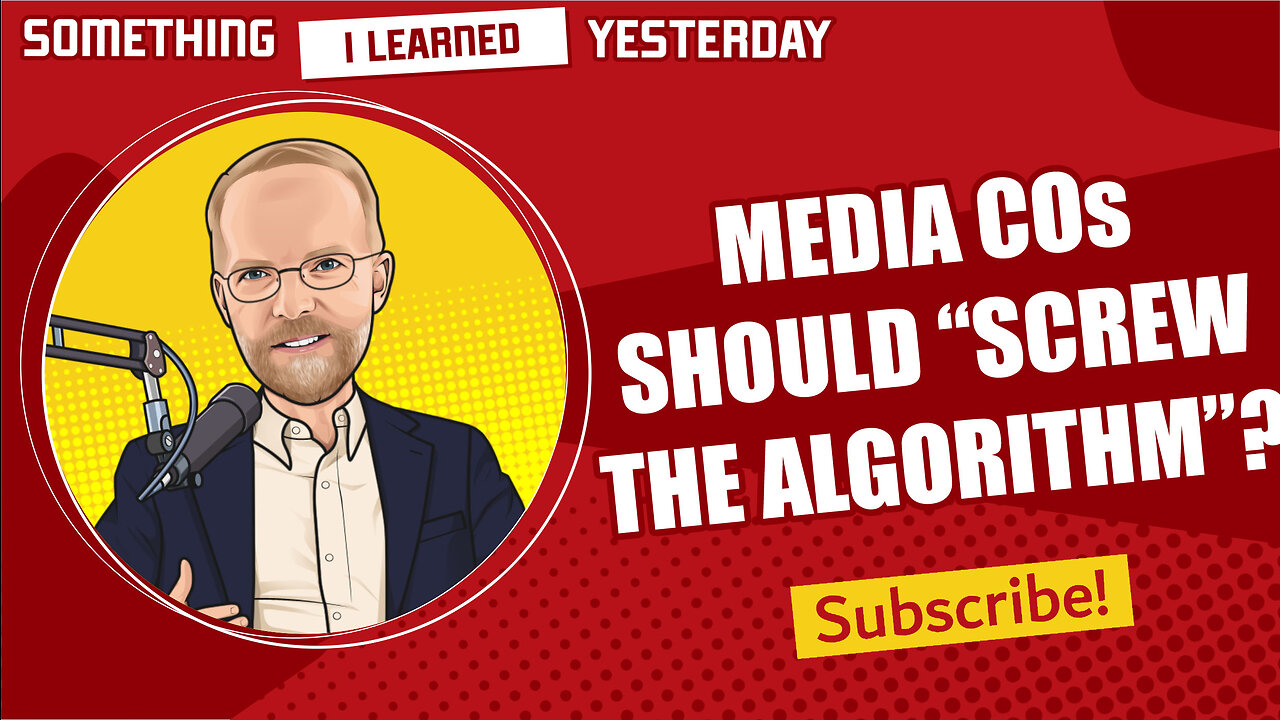Premium Only Content

132: Publishing companies need a unique point of view
Media is about a promise of personal transformation
A recent episode of the “People vs. Algorithms” podcast titled “Chris Kimball Says Screw the Algorithm” provides some very timely and important lessons for publishers.
You can skip to 6:51 if you’re in a hurry.
Chris wanted to build a new kind of media business. He was publishing a magazine in the 80s. He was competing with Conde Nast, etc. The whole system was based on giving away the subscription to get the eyeballs to sell to advertisers. That undermines the value of the content.
He relaunched his cooking magazine – I think it was Cooks Illustrated? – as 32 black and white pages plus cover. He thought black and white would make people feel that the content itself is more valuable. I.e., if you’re not selling pretty pictures, you must be selling useful words.
Brian Morrissey said stripping away all the frippery of media gave it more credibility and authenticity.
Chris says at the heart of any successful media company is the idea that the subscriber will be personally transformed. Everybody wants to be somebody else. If you can help transform somebody, that’s the highest perceived value you can offer.
For his brand, if they can transform the reader’s cooking, they’ll transform the reader. He’ll be a happier, more confident person.
Chris’ brand goes beyond the magazine. They have a TV show on PBS, a store, cooking classes, and other things.
Troy Young says for most media companies that start on an e-commerce business, it will either be a rounding error, or it will fail. But Chris got it right, and I think part of that is that they’re not relying on the content to sell the products.
As Brian pointed out, when people are reading a recipe or an article, they’re not in buying mode. That’s a mistake many companies make. You need the content and the products to mesh, but don’t expect your content to sell your products.
Chris also said that the way to make money with e-commerce is to create and manufacture your own products. You need your cost of goods to be 20 percent or lower so you can afford advertising and still make a profit.
Then the store becomes the top of the funnel for membership. After someone has purchased some pepper and some knives, they might sign up for the magazine.
Content doesn’t act as a funnel to the product side of the business. They’re two very separate businesses. But creating the content puts them in touch with people and concepts they need to know what kinds of products to create.
Chris also says a media company needs a point of view. In the context of cooking, it’s not about having lots of recipes, it’s about having the right recipes.
In the social media world, that recipe or cooking concept has to be intriguing and deliver a memorable story in about 60 seconds.
If you look at YouTube, you can see that everybody follows certain practices. E.g., all the thumbnails have “surprised guy face,” as Brian put it. But Chris says screw the algorithm. Do something different. You’ll never survive in a “me too” environment because there are too many options out there. You need to be different. The chances of being successful in a copycat environment are almost zero.
The last point I want to touch on fits with what I’ve been saying in my last couple of videos, which is that the volume of viewers has nothing to do with how many people are attached to your brand. That’s what I meant when I said that the advertising model – where you pursue reach and volume – leads you down the wrong path.
Resources
Chris Kimball Says Screw the Algorithm
https://podcasts.apple.com/us/podcast/chris-kimball-says-screw-the-algorithm/id1642958293?i=1000631082016
-
 1:14:05
1:14:05
Tucker Carlson
3 hours ago“I’ll Win With or Without You,” Teamsters Union President Reveals Kamala Harris’s Famous Last Words
71K227 -
 1:58:31
1:58:31
The Dilley Show
3 hours agoTrump Conquering Western Hemisphere? w/Author Brenden Dilley 12/23/2024
59.7K9 -
 1:09:59
1:09:59
Geeks + Gamers
4 hours agoSonic 3 DESTROYS Mufasa And Disney, Naughty Dog Actress SLAMS Gamers Over Intergalactic
32.7K9 -
 51:59
51:59
The Dan Bongino Show
5 hours agoDemocrat Donor Admits The Scary Truth (Ep. 2393) - 12/23/2024
569K1.61K -
 2:32:15
2:32:15
Matt Kohrs
16 hours agoRumble CEO Chris Pavlovski Talks $775M Tether Partnership || The MK Show
90.7K27 -
 28:23
28:23
Dave Portnoy
16 hours agoDavey Day Trader Presented by Kraken - December 23, 2024
112K34 -
 59:29
59:29
BonginoReport
7 hours agoTrump, Murder Plots, and the Christmas Miracle: Evita + Jack Posobiec (Ep.110) - 12/23/2024
126K113 -
 2:59:14
2:59:14
Wendy Bell Radio
10 hours agoNothing To See Here
106K60 -
 2:12:18
2:12:18
TheDozenPodcast
1 day agoIslam vs Christianity: Bob of Speakers' Corner
99.8K24 -
 14:36
14:36
The StoneZONE with Roger Stone
1 day agoRoger Stone Delivers Riveting Speech at Turning Point’s AMFEST 2024 | FULL SPEECH
121K28